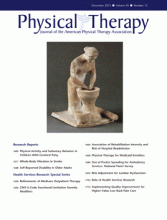Abstract
Background Reduced participation in physical activity and increased time spent in sedentary behavior are associated with overweight, chronic disease, and disability. In order to optimize recommendations and interventions to increase physical activity and reduce sedentary behavior in children with cerebral palsy (CP), knowledge of their physical activity and sedentary behavior is needed.
Objectives The aim of this study was to describe light, moderate, and vigorous physical activity and sedentary behavior in preadolescent children with and without CP and compare physical activity and sedentary behavior between the 2 groups.
Design This was a cross-sectional study of 33 children, aged 6 to 10 years, with CP (Gross Motor Function Classification System [GMFCS] levels I–III) and 33 age- and sex-matched children with typical development.
Methods Physical activity was measured using the RT3 accelerometer over 7 days.
Results Children with CP spent more time in sedentary behavior and accumulated less total activity, moderate activity, vigorous activity, and sustained bouts of moderate-to-vigorous activity (MVPA). They also accumulated a fewer number of bouts of MVPA and vigorous activity, despite spending a similar amount of time in each bout.
Limitations The small number of children in GMFCS levels II and III did not allow for adjustment for GMFCS level when comparing physical activity between children with and without CP.
Conclusions Preadolescent children with CP spent less time in moderate and vigorous activity and more time in sedentary behavior than children with typical development. Children with CP also accumulated less continuous MVPA and vigorous activity as a result of achieving fewer sustained bouts of MVPA and vigorous activity throughout the day.
Footnotes
Dr Ryan, Dr Hussey, and Dr Gormley provided concept/idea/research design. All authors provided writing. Dr Ryan, Dr Forde, and Dr Hussey provided data collection and analysis. Dr Gormley and Dr Hussey provided project management, facilities/equipment, and institutional liaisons. Dr Forde, Dr Hussey, and Dr Gormley provided consultation (including review of manuscript before submission).
Ethical approval for this study was obtained from the Faculty of Health Sciences' Ethics Committee, the Central Remedial Clinic's Ethics Committee, and Enable Ireland's Research Ethics and Quality Committee.
- Received August 6, 2014.
- Accepted May 21, 2015.












